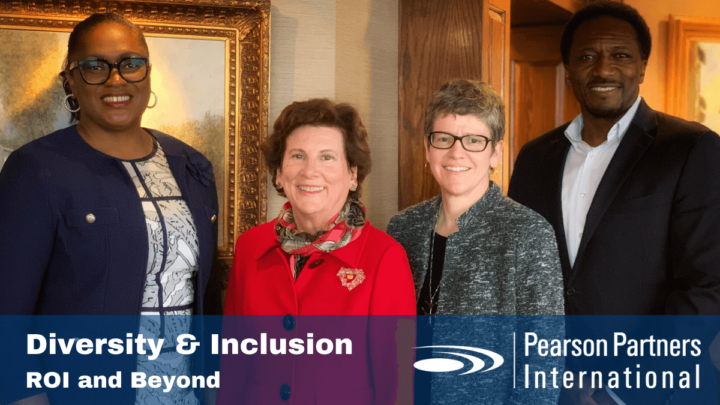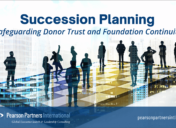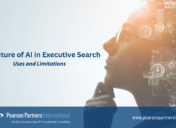Diversity and Inclusion: ROI, Business and Cultural Impacts
Diversity and inclusion strategies can deliver return on investment beyond just numbers. Representation is a measure of diversity and employee experience is a measure of inclusion. Both increase productivity and profitability. Yet, many organizations approach diversity initiatives by simply “checking off the boxes” for recruitment and reputation management. To explore best practices for inclusion and diversity strategy, we invited a panel of diversity and inclusion leaders to share their thoughts and experiences at our March 3, 2020, Spotlight SeriesSM breakfast.
Esteemed Panel
Our panel was moderated by Pearson Partners Vice Presidents Lisa Thompson and Carolyn Simons and included:
- Traci Dunn, Vice President of Inclusion, Diversity & Corporate Impact, McKesson
- Ellen Farrell, Vice President of Social Innovation and Executive Advisor, Toyota Motor North America
- Bobby Griffin, Vice President of Diversity & Inclusion, CBRE
- Whitney Johns Martin, Managing Director and Co-Founder, Texas Women Ventures
Inclusion means truly valuing differences and being intentional about creating an environment where differences can work to benefit the organization and its customers.
The Evolution of Diversity and Inclusion
Diversity reflects inclusivity. Organizations that are truly inclusive in attracting, developing and retaining talent can gauge results using diversity as a measure. “Inclusion” doesn’t mean tolerating differences. It means truly valuing differences and being intentional about creating an environment where differences can work to benefit the organization and its customers.
A growing number of companies have implemented formal diversity and inclusion initiatives, with dedicated leaders at high levels. These diversity and inclusion (D&I) roles have evolved from a human resources function to a leadership initiative, with diversity as a priority that is integrated into every aspect of the talent lifecycle.
D&I work is still closely aligned with human resources, yet the role may also touch everything from culture development and employee engagement to corporate impact and foundation work. By intentionally partnering with talent-focused efforts, rather than working in a silo, D&I leaders can align and integrate their efforts across the organization to make a systemic impact.
The Value of Diversity and Inclusion
A diverse organization is better equipped to support a diverse customer base. But it’s not just about “looking like your customer”, it’s about thinking like your customer by bringing a wide range of perspectives and viewpoints to the table. It’s about connecting D&I as an enabler of success—particularly in areas where an organization may not have led in the past.
Diversity of thought feeds innovation, which pushes organizations forward into new growth opportunities.
D&I is also critical for attracting and retaining the best talent in a tight labor market. Creating an environment where people feel free to bring their authentic selves to work fosters an open market of ideas. In workplaces where all employees’ opinions, voices and ideas truly matter, organizations are better able to retain their people because they feel welcome, respected and valued. Recruiting and retaining diverse talent creates a diverse organization over time. It’s important to ensure that position descriptions do not have built-in biases that could rule certain people out and that D&I efforts are supported across the organization with ongoing training on unconscious bias, bias interrupters, inclusive leadership and cultural competence.
Generational and Gender Diversity
D&I efforts also capitalize on diversity across generations in the workplace. Some organizations have created employee resource groups for emerging professionals to create a forum for multigenerational perspectives and help shape internal policies and procedures.
Mentoring and reverse mentoring across generations can encourage employees of all ages to share what they bring to the table and can help create an inclusive environment.
Women-led businesses, or those with gender-inclusive management teams, often struggle with access to venture capital, in part because the investment community is male-dominated. In the late 1980s and early 1990s, about 1 percent of private equity money went to female entrepreneurs. Today, with a growing number of women involved in investment committees and serving as investors, that figure has risen to about 3 percent—but there is a long way to go in involving more women in the investment community and increasing access to capital for women-owned businesses. About 65 percent of investment funds are currently guided solely by male decision-makers.
Diverse Leadership
Employee engagement surveys help ensure that team members feel their opinions are valued. They can also help gauge the success of D&I efforts by evaluating data about specific demographics. Incorporating D&I-related measures into overall measures of success and tying them to executive compensation can help embed diversity efforts into company culture from the top down.
Diversity at the top sets the stage for a diverse and inclusive organization.
A diverse executive team and board of directors are well-equipped to intentionally lead with D&I in mind, while bringing diversity of perspective to organizational leadership and culture. By being intentional about supporting every employee’s growth and aspirations within the organization, leaders can build cultural competence to create a truly inclusive environment where the benefits of diverse thought can thrive.















